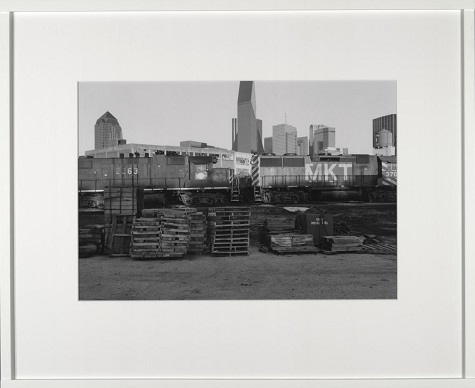Prior to moving to Dallas, I found myself doing a lot of research about how to navigate the city. As a person that doesn’t have a car or know how to drive, I knew without a doubt I would be depending on the DART system. As my bus moves down Ross Ave in morning traffic, I can take time to look out the windows and get glimpses of Dallas, soaking in the details that might be missed otherwise.
The study of public transportation can show how cities both shape and are shaped by these models. While public transportation attempts to create access for ever growing cities, the nature of this large scale building has seen its share of highs and lows throughout its long history. Although DART is fairly new to Dallas (1980s), we can see the way neighborhoods around stops have changed and developed as lines have been added. Trains and buses have been of interest to artists around the world, and the DMA has a number of works that explore their many facets.

Lothar Baumgarten, Missouri-Kansas-Texas Railroad, Katy Yard, Continental Viaduct, Dallas, Dallas County, Texas, negative 1989, gelatin silver print, Dallas Museum of Art, gift of the artist and Marian Goodman Gallery, 2004.41.2, © Lothar Baumgarten / Artists Rights Society (ARS), New York / VG Bild-Kunst, Bonn
In 1989, German artist Lothar Baumgarten dedicated six months to following America’s railroad tracks to create the series, Carbon. This image shows the Katy, also known as the Missouri-Kansas-Texas Railroad. Today this railyard has been replaced by the American Airlines Center. The Katy was the first railroad to connect Texas to the rest of the United States in the late 1800s, and it served as a way to transport goods such as cotton across the United States. Baumgarten addresses the irony of the beautiful landscapes that were made available for public consumption as tracks were laid across fields, but also the destruction that comes with it. In addition, he looks at the human accomplishment of settling the land that carried with it the cost of displacing communities. Finally, this work addresses the decline of the railroads themselves as they became industrial transportation.

Willard Watson, Untitled, 1985, drawings, Dallas Museum of Art, gift of the Friends of Willard Watson, 1985.181.4 © Estate of Willard Watson
Willard Watson, “The Texas Kid,” reminisces about when his family moved to Texas from Louisiana in his series of drawings, Life Story. Watson’s family were sharecroppers, a system where the landowner allows a tenant to use the land in exchange for a share of the crop. However, this system often kept tenant farm families severely indebted, with many laws in place to favor the landowners position. This particular image shows the way railroad travel could be empowering, as Watson writes at bottom, “when we were coming across this bridge going to Dallas, Daddy said we were home free.”
Just as these artists were inspired by their experiences with transportation, the DART Student Art Contest invites students to create works of art inspired by DART. Come visit the DMA to get inspiration for your DART contest submissions, which are due February 28. I can’t wait to see the Best of Show winner across the DART bus on my daily commute, along with all the other finalists on view at the DMA in April!
Olivia Feal is the McDermott Intern for Interpretation at the DMA